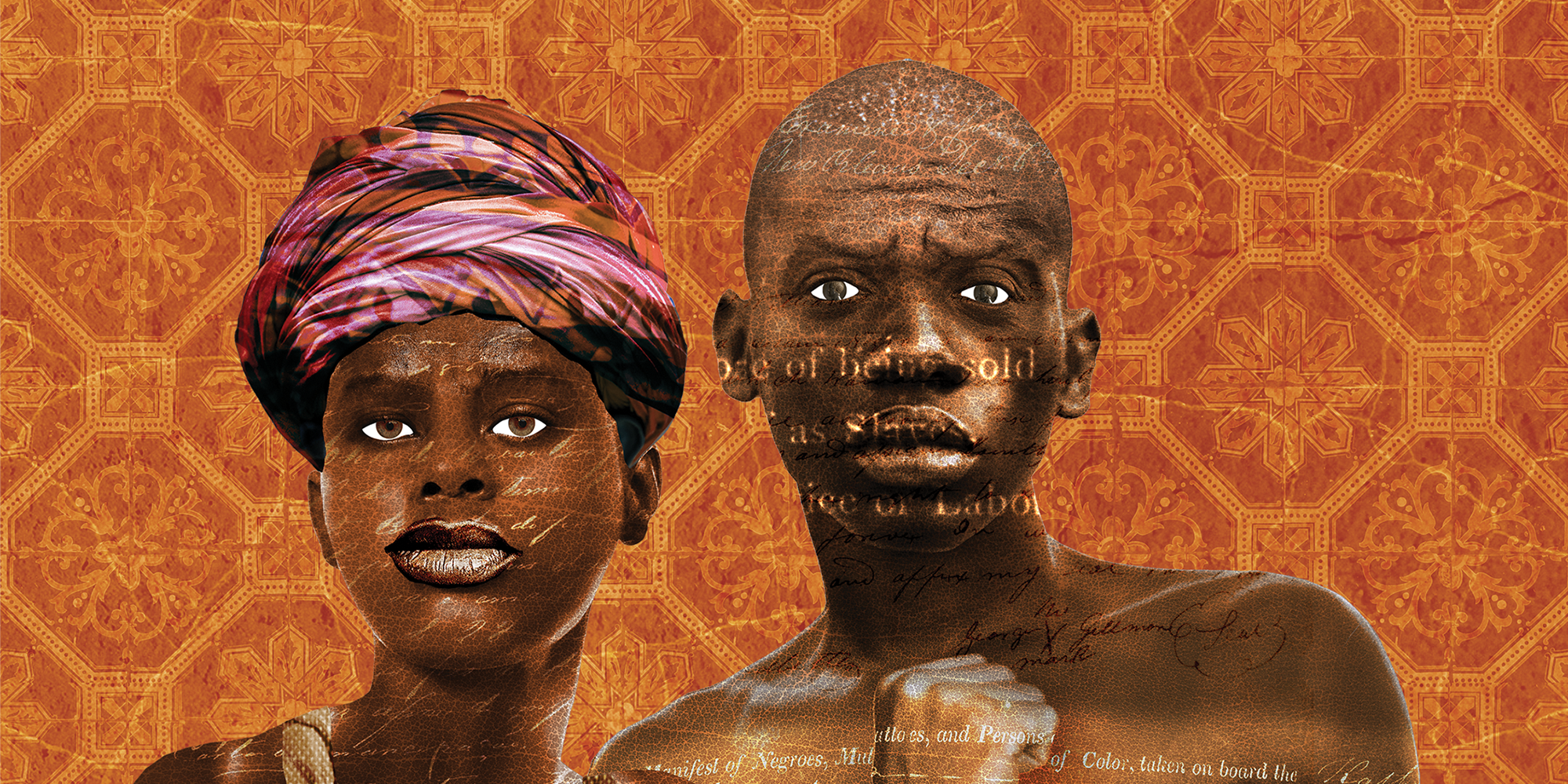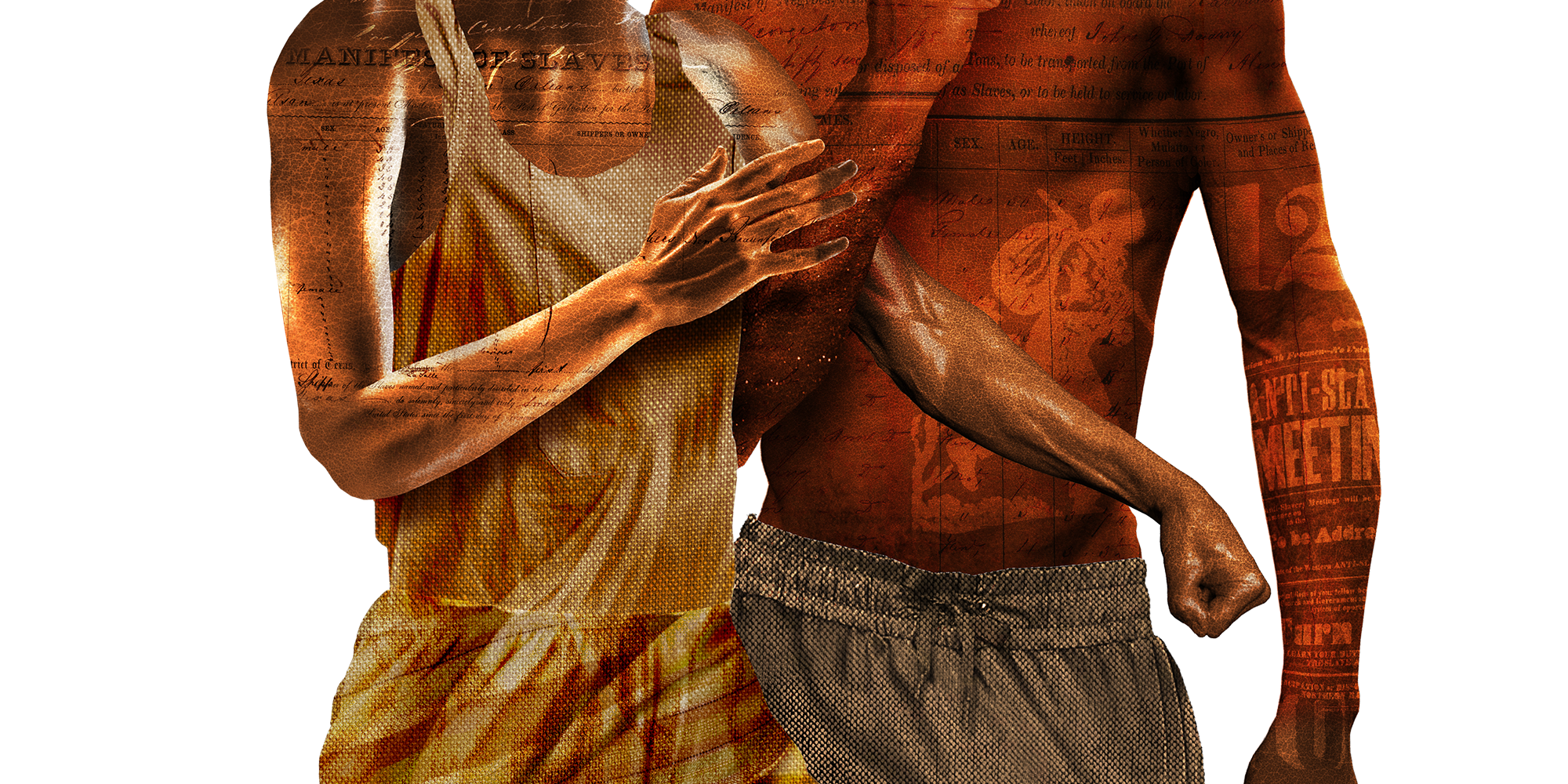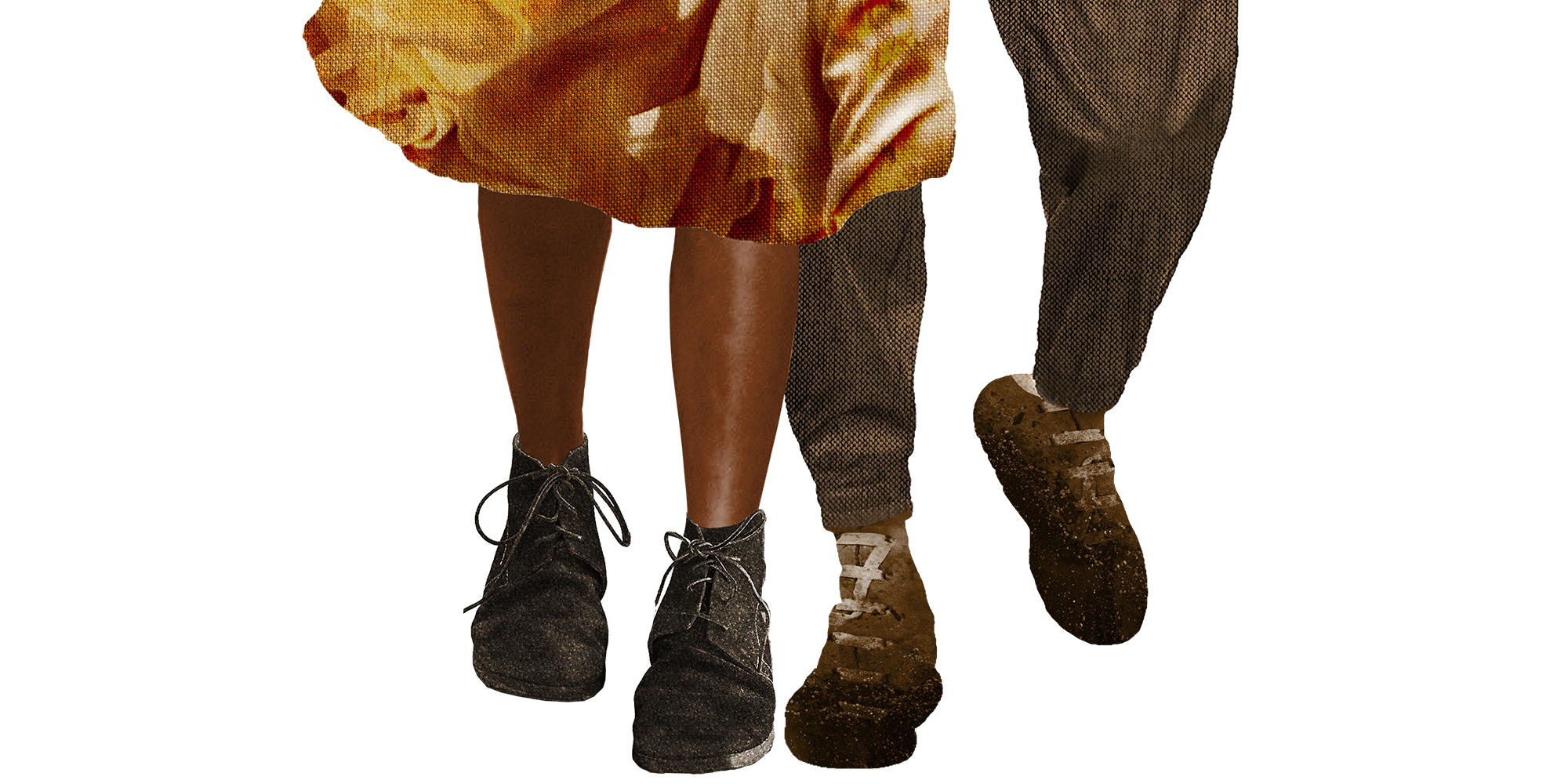
Illustration by Dave McClinton
A Christian Call for Reparations
TO THE BEST of our historical knowledge, in August 1619 a ship named White Lion landed at a coastal port near Point Comfort, Va., carrying 20 to 30 captive Africans to be sold into slavery. This landing symbolizes the construction of race as a defining and indelible feature of America’s core identity. It stamped black bodies with the ineradicable identity of subhuman chattel. As such, it signaled the white supremacist foundation upon which America’s capitalistic democracy, with all its sociopolitical systems and structures, would be built.
Today, the legacy of the White Lion landing prevails in almost every sector of American life. Black people continue to suffer 21st century versions of slavery, such as poverty, mass incarceration, and substandard schools. More than 400 years after the White Lion landing, two things are clear: As Nikole Hannah-Jones reminds us in The New York Times’ 1619 Project, there has never “been a genuine effort to redress the wrongs of slavery and the century of racial apartheid that followed,” and there has been no genuine effort to truly end white supremacist injustice itself. Consequently, there have been renewed calls for reparations.
The Black Manifesto
THE IDEA OF reparations was brought back to public attention in 2014 when Ta-Nehisi Coates wrote “The Case for Reparations” in The Atlantic, making clear that until the nation reckons with its “compounding moral debts, America will never be whole.” As this is true for the nation in general, it is likewise true for faith communities, as the authors of what became known as the Black Manifesto recognized more than 50 years ago.
In May 1969, civil rights leader James Forman disrupted the services of Riverside Church in Manhattan to deliver the Black Manifesto written at the National Black Economic Development Conference, which had convened in Detroit. The manifesto demanded $500 million for reparations from “white churches and Jewish synagogues” for “aiding and abetting” the “exploitation of colored peoples around the world.”
This money was to be used for a range of programs to support economic growth, educational opportunities, and the psychological well-being of the black community.
While some white and Jewish faith communities, as well as seminaries, responded by giving funds to various projects and organizations within the black community, the Black Manifesto’s goals never came to fruition.
Now, more than 50 years later, various religious institutions and faith communities are responding to the renewed call for reparations by Coates and others. For example, the Episcopal Church’s Virginia Theological Seminary in Alexandria has set aside $1.7 million for a reparations fund. Princeton Theological Seminary in New Jersey established a $27 million endowed fund to address historical theft of labor and discrimination. These and other institutions have set up funds to pay or provide scholarships to descendants of the enslaved people who provided the labor upon which their buildings and wealth have been built, while also finding ways to support various black ministries. However, the question remains: Is this enough?

Illustration by Dave McClinton
What must reparations look like?
NOTWITHSTANDING THE FACT that no amount of financial reparations can compensate for the generational harm and injustice black people have suffered due to the sin of white supremacy, some form of reparation remedies is in order to at least repair the ever-widening breach of inequities between the white and black communities. This breach has been made ever more evident during the COVID-19 crisis. Longstanding structural and systemic inequalities and ongoing racial bias have resulted in black communities being disproportionately impacted by the virus. Nevertheless, for faith communities it must be about more than compensatory reparations in the attempt to repair the harm that has been done.
For inasmuch as faith is about partnering with God to mend an unjust earth, and thus to move us toward a more just future, then faith communities by definition are accountable to that future.
This means that for them, reparations should be directed toward building a future where all human beings are respected as the sacred creations that they are and thereby free to live into the fullness of their sacred creation. For faith communities, reparations must not be only an effort to compensate for past harms, they must also chart a pathway to a just future. Otherwise, reparations become little more than a salve for white guilt while the sin of white supremacy continues to thrive.
What then must reparations look like? There are at least three key aspects for any form of reparations that emerge from the wider faith community.

‘Do this in memory of me’
AS MANY CONTINUE to examine the complex and multidimensional legacy of the White Lion, the related legacy of faith communities is often overlooked.
In faith communities, reparations must begin with anamnestic truth-telling. Anamnesis means “memorial sacrifice.” Its origins are in Jesus’ words, “Do this in memory of me” (Luke 22:19). This is not a passive process but one in which Christians enter into the sacrifice. It is about being accountable to the past in the very present.
For faith communities, such truth-telling is not merely a retrospective accounting of one’s culpability in white supremacist realities in an effort to apologize for and perhaps be pardoned for past misdeeds. Rather, anamnestic truth-telling confronts the ways in which the past remains alive in the present, thus paving the way to right the present by exonerating it from contemporary vestiges of the past.
Such truth-telling means first confronting the ways in which ecclesial and institutional systems, structures, and cultural norms reflect white supremacist narratives, ideologies, and constructs—then intentionally working to dismantle and transform them.
For instance, it is no coincidence that most black bishops in my own Episcopal faith community have not led dioceses, but instead were elected as suffragans to assist the diocesan bishop. The role of suffragan bishops was established, in part, to elevate black priests to the episcopacy, thus sparing white bishops from the “humiliating” task of caring for black souls. At the same time, the role withheld actual episcopal authority from those same black suffragans—such as the right to vote in church conventions and the right to succeed the diocesan bishops above them. Moreover, the Episcopal Church must acknowledge that, given its past as the church of wealthy slaveholders, it is not a coincidence that, in 2018, the church’s racial demographic was whiter than the U.S. racial demographic in 1790.
Anamnestic truth-telling also acknowledges the ways seminaries continue to perpetuate a culture that has made it difficult for black people to attain a theological education. How is it that the culture that denied pioneering priest and educator Alexander Crummell entry into General Theological Seminary in 1839 persists in new and updated ways in various seminaries today?
A second aspect of anamnestic truth-telling recognizes the theological legacy of white supremacy within various faith traditions. One must recognize the way in which Christianity’s monotheistic claims not only provided justification for enslaving black people and sacred legitimation for white supremacist policies such as the Discovery Doctrine, but also continue to provide theological legitimation for aggressive policies that dehumanize, if not destroy, people who are seen as religiously or culturally different, tacitly fostering a kind of Christian nationalism. In this way, it is perhaps no accident that the majority of white U.S. Christians today support “protectionist” policies.
The point of the matter is that reparations must involve an interrogation of the ways in which fundamental aspects of Christian theology have been used to legitimate white supremacist realities and have become a part of the collective theological consciousness. As such, they have unwittingly fostered support for white supremacist policies and ideologies. Such interrogation is particularly imperative for theological seminaries as they prepare future faith leaders. If seminary and theological curricula do not critically interrogate the white supremacist implications of Christian theological claims, then seminarians will have little chance of doing better than previous generations when it comes to dismantling a white supremacist culture and society, let alone church.
In the end, it is only with anamnestic truth-telling that “repairing” the harm of white supremacy can begin. What is needed in our faith communities, as Ta-Nehisi Coates has written, “is an airing of family secrets, a settling with old ghosts,” lest those old ghosts continue to haunt us.
Fostering moral identity
THIS LEADS TO another aspect of reparations for faith communities: fostering a moral identity.
Fostering a moral identity in a society shaped by a white supremacist culture that privileges whiteness even as it penalizes people of color, sometimes unto death, means to self-consciously name and intentionally denounce white privilege. Maintaining white privilege is not about “being racist”; rather, it is about benefitting from white supremacist realities. One does not have to be overtly racist to do that.
Choosing whiteness—even when it is simply a passive refusal to confront what it means to be a beneficiary of white supremacy and its legacy—is an immoral choice. As such, it betrays our common humanity as equal children of God. For the Christian faith community, whiteness further belies our core identity as a faith tradition with a crucifixion at its center.
That Jesus was crucified, and refused to save himself from being crucified, reveals that he emptied himself of all privilege that might separate him from the victims of the deadly political, cultural, and religious realities of his day.
Through this shedding of power, Jesus at once denounced the crucifying privileges of whiteness while affirming the crucified realities of blackness. Theologian Jon Sobrino put it this way: “The cross, for its part, tells of God’s affinity with victims.”
What is made clear, therefore, is that one cannot be at once white and Christian. To claim whiteness is essentially to make peace with crucifying privilege—thus complying with the crucifying realities of white supremacy. Ecclesiastical institutions and faith communities must lead the way toward claiming a moral identity by naming and freeing themselves from their own institutional realities of white privilege.

Illustration by Dave McClinton
Act as if the future is now
THIS BRINGS US to a final crucial aspect of reparations for faith communities: proleptic participation. If faith communities and institutions are to repair the breach between the unjust present and God’s just future, then they must act proleptically; that is, as if that future is now. This means that faith communities must be an active presence in the public square as sanctuary and witness.
To be a sanctuary necessitates that no individual should feel diminished or unsafe because of who they are or are not within a faith community or institution. Faith leaders must work to make their spaces free of bigotry or intolerance, not simply in the most overt ways that these are expressed but also in the subtle ways that often go unnoticed. These ways may be embedded in the fabric of buildings or even in the fabric of programming, curriculums, and worship.
What are the images and icons in our churches and seminaries? What is the story they tell? And who tells it? What is the music that is played? These are the kind of questions necessary for faith communities to be a sanctuary for all people.
Furthermore, it is important to recognize that images of a Black Christ are important for more than just black congregations, just as bilingual worship is important for more than just Latinx congregations or congregations with Latinx congregants. Including these things in faith communities where people of color are not significantly present signals the sacredness of bodies and cultures of people of color—thus defying white supremacist cultural and ideological narratives.
Faith communities must also witness to God’s just future. This requires nothing less than calling out racism, xenophobia, and any other forms of dehumanization, even when they masquerade in politically correct language like “greatness.” Put simply, silence, indifference, and passivity are not options. Faith communities do not have the option, as Martin Luther King Jr. once said, to remain “silent behind the anesthetizing security of stained-glass windows.”
To be a witness demands that faith communities boldly lead the way toward building a just society, thereby freeing the nation from its captivity to the sinful, systemic, structural, cultural, and ideological legacy of the White Lion.
Repairing for generations to come
NOT LONG AGO I attended a meeting with seminary leaders where reparations were discussed. One attendee offered that he was grateful that none of his institution’s buildings were built with enslaved labor, so the matter of reparations was not one that his institution had to engage.
Of the many issues that I had with his declaration—let alone my doubts regarding the veracity of that claim for a Southern institution—I was affirmed in my belief that the “reparations” being offered by many faith communities and institutions were not reparations at all. The fact of the matter is—after the money has been paid to enslaved ancestors or for scholarships and other programming—systems and structures are not disrupted. Life goes on as usual—and these institutions continue to benefit from the ongoing legacy of white supremacy to the detriment of people of color.
Four hundred years after the White Lion brought the economics of chattel slavery to English-speaking America, and more than 50 years after James Forman demanded white and Jewish faith communities make economic reparations to descendants of enslaved people, we are only slowly, in some places, beginning to even recognize the need for truth-telling, claiming moral identities, and living as if the future is now.
At the end of the day, God calls us all to a future where the first are last and the last are first (Matthew 20:16). Such a future does not reflect a reversal of privilege and penalty. Rather, it is a time when there is no first or last because everyone is treated and respected as the equal child of God that they are. It is left for faith communities to “repair the breach” between the present injustice and God’s just future. Reparations must not simply look back, but most importantly must push forward.
Got something to say about what you're reading? We value your feedback!


